Cambridge Series In Statistical And Probabilistic Mathematics Pdf
We use cookies to distinguish you from other users and to provide you with a better experience on our websites. Close this message to accept cookies or find out how to manage your cookie settings.


This series of high quality upper-division textbooks and expository monographs covers all areas of stochastic applicable mathematics. The topics range from pure and applied statistics to probability theory, operations research, mathematical programming, and optimisation. The books contain clear presentations of new developments in the field and also of the state of the art in classical methods. While emphasising rigorous treatment of theoretical methods, the books also contain applications and discussions of new techniques made possible by advances in computational practice.
- Editorial Boards: , Universiteit Leiden, B. D. Ripley, University of Oxford, S. Ross, University of Southern California, Z. Ghahramani, University of Cambridge, M. Stein, University of Chicago, F. P. Kelly, University of Cambridge
- View selected items
- Save to my bookmarks
- Export citations
- Download PDF (zip)
- Send to Kindle
- Send to Dropbox
- Send to Google Drive
52 results in Cambridge Series in Statistical and Probabilistic Mathematics
-
The Fundamentals of Heavy Tails
- Properties, Emergence, and Estimation
- Jayakrishnan Nair , Adam Wierman , Bert Zwart
- Coming soon
- Expected online publication date: June 2022
- Print publication: 31 May 2022
-
- Book
-
-
- Export citation
-
-
Heavy tails –extreme events or values more common than expected –emerge everywhere: the economy, natural events, and social and information networks are just a few examples. Yet after decades of progress, they are still treated as mysterious, surprising, and even controversial, primarily because the necessary mathematical models and statistical methods are not widely known. This book, for the first time, provides a rigorous introduction to heavy-tailed distributions accessible to anyone who knows elementary probability. It tackles and tames the zoo of terminology for models and properties, demystifying topics such as the generalized central limit theorem and regular variation. It tracks the natural emergence of heavy-tailed distributions from a wide variety of general processes, building intuition. And it reveals the controversy surrounding heavy tails to be the result of flawed statistics, then equips readers to identify and estimate with confidence. Over 100 exercises complete this engaging package.
-
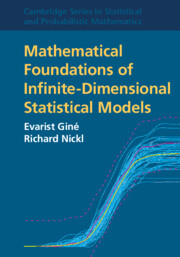
-
Mathematical Foundations of Infinite-Dimensional Statistical Models
- Evarist Giné , Richard Nickl
- Published online: 05 March 2021
- Print publication: 25 March 2021
-
- Book
-
- Get access
-
- Export citation
-
-
In nonparametric and high-dimensional statistical models, the classical Gauss–Fisher–Le Cam theory of the optimality of maximum likelihood estimators and Bayesian posterior inference does not apply, and new foundations and ideas have been developed in the past several decades. This book gives a coherent account of the statistical theory in infinite-dimensional parameter spaces. The mathematical foundations include self-contained 'mini-courses' on the theory of Gaussian and empirical processes, approximation and wavelet theory, and the basic theory of function spaces. The theory of statistical inference in such models - hypothesis testing, estimation and confidence sets - is presented within the minimax paradigm of decision theory. This includes the basic theory of convolution kernel and projection estimation, but also Bayesian nonparametrics and nonparametric maximum likelihood estimation. In a final chapter the theory of adaptive inference in nonparametric models is developed, including Lepski's method, wavelet thresholding, and adaptive inference for self-similar functions. Winner of the 2017 PROSE Award for Mathematics.
-
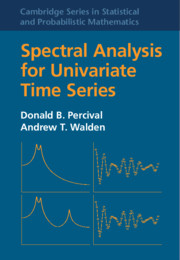
-
Spectral Analysis for Univariate Time Series
- Donald B. Percival , Andrew T. Walden
- Published online: 17 March 2020
- Print publication: 19 March 2020
-
- Book
-
- Get access
-
- Export citation
-
-
Spectral analysis is widely used to interpret time series collected in diverse areas. This book covers the statistical theory behind spectral analysis and provides data analysts with the tools needed to transition theory into practice. Actual time series from oceanography, metrology, atmospheric science and other areas are used in running examples throughout, to allow clear comparison of how the various methods address questions of interest. All major nonparametric and parametric spectral analysis techniques are discussed, with emphasis on the multitaper method, both in its original formulation involving Slepian tapers and in a popular alternative using sinusoidal tapers. The authors take a unified approach to quantifying the bandwidth of different nonparametric spectral estimates. An extensive set of exercises allows readers to test their understanding of theory and practical analysis. The time series used as examples and R language code for recreating the analyses of the series are available from the book's website.
-
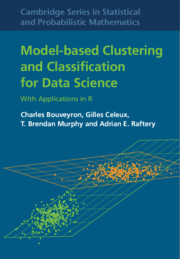
-
Model-Based Clustering and Classification for Data Science
- With Applications in R
- Charles Bouveyron , Gilles Celeux , T. Brendan Murphy , Adrian E. Raftery
- Published online: 14 June 2019
- Print publication: 11 July 2019
-
- Book
-
- Get access
-
- Export citation
-
-
Cluster analysis finds groups in data automatically. Most methods have been heuristic and leave open such central questions as: how many clusters are there? Which method should I use? How should I handle outliers? Classification assigns new observations to groups given previously classified observations, and also has open questions about parameter tuning, robustness and uncertainty assessment. This book frames cluster analysis and classification in terms of statistical models, thus yielding principled estimation, testing and prediction methods, and sound answers to the central questions. It builds the basic ideas in an accessible but rigorous way, with extensive data examples and R code; describes modern approaches to high-dimensional data and networks; and explains such recent advances as Bayesian regularization, non-Gaussian model-based clustering, cluster merging, variable selection, semi-supervised and robust classification, clustering of functional data, text and images, and co-clustering. Written for advanced undergraduates in data science, as well as researchers and practitioners, it assumes basic knowledge of multivariate calculus, linear algebra, probability and statistics.
-
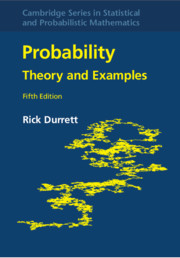
-
Probability
- Theory and Examples
- 5th edition
- Rick Durrett
- Published online: 05 April 2019
- Print publication: 18 April 2019
-
- Book
-
- Get access
-
- Export citation
-
-
This lively introduction to measure-theoretic probability theory covers laws of large numbers, central limit theorems, random walks, martingales, Markov chains, ergodic theorems, and Brownian motion. Concentrating on results that are the most useful for applications, this comprehensive treatment is a rigorous graduate text and reference. Operating under the philosophy that the best way to learn probability is to see it in action, the book contains extended examples that apply the theory to concrete applications. This fifth edition contains a new chapter on multidimensional Brownian motion and its relationship to partial differential equations (PDEs), an advanced topic that is finding new applications. Setting the foundation for this expansion, Chapter 7 now features a proof of Itô's formula. Key exercises that previously were simply proofs left to the reader have been directly inserted into the text as lemmas. The new edition re-instates discussion about the central limit theorem for martingales and stationary sequences.
-
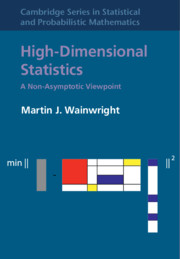
-
High-Dimensional Statistics
- A Non-Asymptotic Viewpoint
- Martin J. Wainwright
- Published online: 12 February 2019
- Print publication: 21 February 2019
-
- Book
-
- Get access
-
- Export citation
-
-
Recent years have witnessed an explosion in the volume and variety of data collected in all scientific disciplines and industrial settings. Such massive data sets present a number of challenges to researchers in statistics and machine learning. This book provides a self-contained introduction to the area of high-dimensional statistics, aimed at the first-year graduate level. It includes chapters that are focused on core methodology and theory - including tail bounds, concentration inequalities, uniform laws and empirical process, and random matrices - as well as chapters devoted to in-depth exploration of particular model classes - including sparse linear models, matrix models with rank constraints, graphical models, and various types of non-parametric models. With hundreds of worked examples and exercises, this text is intended both for courses and for self-study by graduate students and researchers in statistics, machine learning, and related fields who must understand, apply, and adapt modern statistical methods suited to large-scale data.
-

-
High-Dimensional Probability
- An Introduction with Applications in Data Science
- Roman Vershynin
- Published online: 29 September 2018
- Print publication: 27 September 2018
-
- Book
-
- Get access
-
- Export citation
-
-
High-dimensional probability offers insight into the behavior of random vectors, random matrices, random subspaces, and objects used to quantify uncertainty in high dimensions. Drawing on ideas from probability, analysis, and geometry, it lends itself to applications in mathematics, statistics, theoretical computer science, signal processing, optimization, and more. It is the first to integrate theory, key tools, and modern applications of high-dimensional probability. Concentration inequalities form the core, and it covers both classical results such as Hoeffding's and Chernoff's inequalities and modern developments such as the matrix Bernstein's inequality. It then introduces the powerful methods based on stochastic processes, including such tools as Slepian's, Sudakov's, and Dudley's inequalities, as well as generic chaining and bounds based on VC dimension. A broad range of illustrations is embedded throughout, including classical and modern results for covariance estimation, clustering, networks, semidefinite programming, coding, dimension reduction, matrix completion, machine learning, compressed sensing, and sparse regression.
-
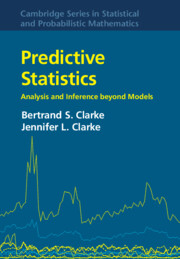
-
Predictive Statistics
- Analysis and Inference beyond Models
- Bertrand S. Clarke , Jennifer L. Clarke
- Published online: 27 April 2018
- Print publication: 12 April 2018
-
- Book
-
- Get access
-
- Export citation
-
-
All scientific disciplines prize predictive success. Conventional statistical analyses, however, treat prediction as secondary, instead focusing on modeling and hence estimation, testing, and detailed physical interpretation, tackling these tasks before the predictive adequacy of a model is established. This book outlines a fully predictive approach to statistical problems based on studying predictors; the approach does not require predictors correspond to a model although this important special case is included in the general approach. Throughout, the point is to examine predictive performance before considering conventional inference. These ideas are traced through five traditional subfields of statistics, helping readers to refocus and adopt a directly predictive outlook. The book also considers prediction via contemporary 'black box' techniques and emerging data types and methodologies where conventional modeling is so difficult that good prediction is the main criterion available for evaluating the performance of a statistical method. Well-documented open-source R code in a Github repository allows readers to replicate examples and apply techniques to other investigations.
-

-
Fundamentals of Nonparametric Bayesian Inference
- Subhashis Ghosal , Aad van der Vaart
- Published online: 22 July 2017
- Print publication: 26 June 2017
-
- Book
-
- Get access
-
- Export citation
-
-
Explosive growth in computing power has made Bayesian methods for infinite-dimensional models - Bayesian nonparametrics - a nearly universal framework for inference, finding practical use in numerous subject areas. Written by leading researchers, this authoritative text draws on theoretical advances of the past twenty years to synthesize all aspects of Bayesian nonparametrics, from prior construction to computation and large sample behavior of posteriors. Because understanding the behavior of posteriors is critical to selecting priors that work, the large sample theory is developed systematically, illustrated by various examples of model and prior combinations. Precise sufficient conditions are given, with complete proofs, that ensure desirable posterior properties and behavior. Each chapter ends with historical notes and numerous exercises to deepen and consolidate the reader's understanding, making the book valuable for both graduate students and researchers in statistics and machine learning, as well as in application areas such as econometrics and biostatistics.
-
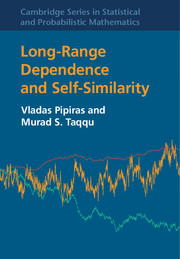
-
Long-Range Dependence and Self-Similarity
- Vladas Pipiras , Murad S. Taqqu
- Published online: 11 May 2017
- Print publication: 18 April 2017
-
- Book
-
- Get access
-
- Export citation
-
-
This modern and comprehensive guide to long-range dependence and self-similarity starts with rigorous coverage of the basics, then moves on to cover more specialized, up-to-date topics central to current research. These topics concern, but are not limited to, physical models that give rise to long-range dependence and self-similarity; central and non-central limit theorems for long-range dependent series, and the limiting Hermite processes; fractional Brownian motion and its stochastic calculus; several celebrated decompositions of fractional Brownian motion; multidimensional models for long-range dependence and self-similarity; and maximum likelihood estimation methods for long-range dependent time series. Designed for graduate students and researchers, each chapter of the book is supplemented by numerous exercises, some designed to test the reader's understanding, while others invite the reader to consider some of the open research problems in the field today.
-
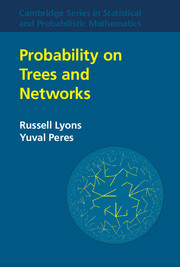
-
Probability on Trees and Networks
- Russell Lyons , Yuval Peres
- Published online: 19 January 2017
- Print publication: 20 January 2017
-
- Book
-
- Get access
-
- Export citation
-
-
Starting around the late 1950s, several research communities began relating the geometry of graphs to stochastic processes on these graphs. This book, twenty years in the making, ties together research in the field, encompassing work on percolation, isoperimetric inequalities, eigenvalues, transition probabilities, and random walks. Written by two leading researchers, the text emphasizes intuition, while giving complete proofs and more than 850 exercises. Many recent developments, in which the authors have played a leading role, are discussed, including percolation on trees and Cayley graphs, uniform spanning forests, the mass-transport technique, and connections on random walks on graphs to embedding in Hilbert space. This state-of-the-art account of probability on networks will be indispensable for graduate students and researchers alike.
-
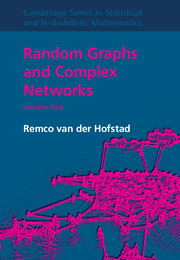
-
Random Graphs and Complex Networks
- Volume 1
- Remco van der Hofstad
- Published online: 12 January 2017
- Print publication: 22 December 2016
-
- Book
-
- Get access
-
- Export citation
-
-
This rigorous introduction to network science presents random graphs as models for real-world networks. Such networks have distinctive empirical properties and a wealth of new models have emerged to capture them. Classroom tested for over ten years, this text places recent advances in a unified framework to enable systematic study. Designed for a master's-level course, where students may only have a basic background in probability, the text covers such important preliminaries as convergence of random variables, probabilistic bounds, coupling, martingales, and branching processes. Building on this base - and motivated by many examples of real-world networks, including the Internet, collaboration networks, and the World Wide Web - it focuses on several important models for complex networks and investigates key properties, such as the connectivity of nodes. Numerous exercises allow students to develop intuition and experience in working with the models.
-
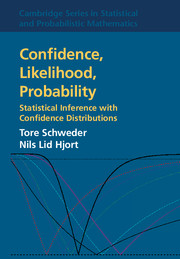
-
Confidence, Likelihood, Probability
- Statistical Inference with Confidence Distributions
- Tore Schweder , Nils Lid Hjort
- Published online: 05 March 2016
- Print publication: 24 February 2016
-
- Book
-
- Get access
-
- Export citation
-
-
This lively book lays out a methodology of confidence distributions and puts them through their paces. Among other merits, they lead to optimal combinations of confidence from different sources of information, and they can make complex models amenable to objective and indeed prior-free analysis for less subjectively inclined statisticians. The generous mixture of theory, illustrations, applications and exercises is suitable for statisticians at all levels of experience, as well as for data-oriented scientists. Some confidence distributions are less dispersed than their competitors. This concept leads to a theory of risk functions and comparisons for distributions of confidence. Neyman–Pearson type theorems leading to optimal confidence are developed and richly illustrated. Exact and optimal confidence distribution is the gold standard for inferred epistemic distributions. Confidence distributions and likelihood functions are intertwined, allowing prior distributions to be made part of the likelihood. Meta-analysis in likelihood terms is developed and taken beyond traditional methods, suiting it in particular to combining information across diverse data sources.
-
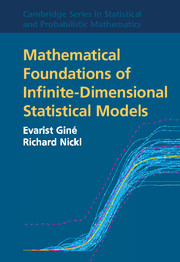
-
Mathematical Foundations of Infinite-Dimensional Statistical Models
- Evarist Giné , Richard Nickl
- Published online: 05 December 2015
- Print publication: 18 November 2015
-
- Book
-
- Get access
-
- Export citation
-
-
In nonparametric and high-dimensional statistical models, the classical Gauss-Fisher-Le Cam theory of the optimality of maximum likelihood estimators and Bayesian posterior inference does not apply, and new foundations and ideas have been developed in the past several decades. This book gives a coherent account of the statistical theory in infinite-dimensional parameter spaces. The mathematical foundations include self-contained 'mini-courses' on the theory of Gaussian and empirical processes, on approximation and wavelet theory, and on the basic theory of function spaces. The theory of statistical inference in such models - hypothesis testing, estimation and confidence sets - is then presented within the minimax paradigm of decision theory. This includes the basic theory of convolution kernel and projection estimation, but also Bayesian nonparametrics and nonparametric maximum likelihood estimation. In the final chapter, the theory of adaptive inference in nonparametric models is developed, including Lepski's method, wavelet thresholding, and adaptive inference for self-similar functions.
-
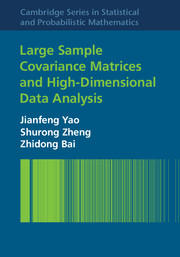
-
Large Sample Covariance Matrices and High-Dimensional Data Analysis
- Jianfeng Yao , Shurong Zheng , Zhidong Bai
- Published online: 05 April 2015
- Print publication: 26 March 2015
-
- Book
-
-
- Export citation
-
-
High-dimensional data appear in many fields, and their analysis has become increasingly important in modern statistics. However, it has long been observed that several well-known methods in multivariate analysis become inefficient, or even misleading, when the data dimension p is larger than, say, several tens. A seminal example is the well-known inefficiency of Hotelling's T2-test in such cases. This example shows that classical large sample limits may no longer hold for high-dimensional data; statisticians must seek new limiting theorems in these instances. Thus, the theory of random matrices (RMT) serves as a much-needed and welcome alternative framework. Based on the authors' own research, this book provides a firsthand introduction to new high-dimensional statistical methods derived from RMT. The book begins with a detailed introduction to useful tools from RMT, and then presents a series of high-dimensional problems with solutions provided by RMT methods.
-
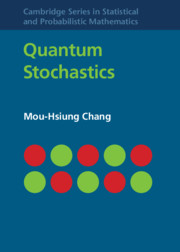
-
Quantum Stochastics
- Mou-Hsiung Chang
- Published online: 05 February 2015
- Print publication: 19 February 2015
-
- Book
-
- Get access
-
- Export citation
-
-
The classical probability theory initiated by Kolmogorov and its quantum counterpart, pioneered by von Neumann, were created at about the same time in the 1930s, but development of the quantum theory has trailed far behind. Although highly appealing, the quantum theory has a steep learning curve, requiring tools from both probability and analysis and a facility for combining the two viewpoints. This book is a systematic, self-contained account of the core of quantum probability and quantum stochastic processes for graduate students and researchers. The only assumed background is knowledge of the basic theory of Hilbert spaces, bounded linear operators, and classical Markov processes. From there, the book introduces additional tools from analysis, and then builds the quantum probability framework needed to support applications to quantum control and quantum information and communication. These include quantum noise, quantum stochastic calculus, stochastic quantum differential equations, quantum Markov semigroups and processes, and large-time asymptotic behavior of quantum Markov semigroups.
-
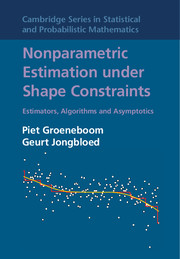
-
Nonparametric Estimation under Shape Constraints
- Estimators, Algorithms and Asymptotics
- Piet Groeneboom , Geurt Jongbloed
- Published online: 18 December 2014
- Print publication: 11 December 2014
-
- Book
-
- Get access
-
- Export citation
-
-
This book treats the latest developments in the theory of order-restricted inference, with special attention to nonparametric methods and algorithmic aspects. Among the topics treated are current status and interval censoring models, competing risk models, and deconvolution. Methods of order restricted inference are used in computing maximum likelihood estimators and developing distribution theory for inverse problems of this type. The authors have been active in developing these tools and present the state of the art and the open problems in the field. The earlier chapters provide an introduction to the subject, while the later chapters are written with graduate students and researchers in mathematical statistics in mind. Each chapter ends with a set of exercises of varying difficulty. The theory is illustrated with the analysis of real-life data, which are mostly medical in nature.
-

-
Analysis of Multivariate and High-Dimensional Data
- Inge Koch
- Published online: 05 June 2014
- Print publication: 02 December 2013
-
- Book
-
- Get access
-
- Export citation
-
-
'Big data' poses challenges that require both classical multivariate methods and contemporary techniques from machine learning and engineering. This modern text equips you for the new world - integrating the old and the new, fusing theory and practice and bridging the gap to statistical learning. The theoretical framework includes formal statements that set out clearly the guaranteed 'safe operating zone' for the methods and allow you to assess whether data is in the zone, or near enough. Extensive examples showcase the strengths and limitations of different methods with small classical data, data from medicine, biology, marketing and finance, high-dimensional data from bioinformatics, functional data from proteomics, and simulated data. High-dimension low-sample-size data gets special attention. Several data sets are revisited repeatedly to allow comparison of methods. Generous use of colour, algorithms, Matlab code, and problem sets complete the package. Suitable for master's/graduate students in statistics and researchers in data-rich disciplines.
-
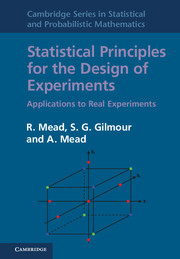
-
Statistical Principles for the Design of Experiments
- Applications to Real Experiments
- R. Mead , S. G. Gilmour , A. Mead
- Published online: 05 November 2012
- Print publication: 13 September 2012
-
- Book
-
- Get access
-
- Export citation
-
-
This book is about the statistical principles behind the design of effective experiments and focuses on the practical needs of applied statisticians and experimenters engaged in design, implementation and analysis. Emphasising the logical principles of statistical design, rather than mathematical calculation, the authors demonstrate how all available information can be used to extract the clearest answers to many questions. The principles are illustrated with a wide range of examples drawn from real experiments in medicine, industry, agriculture and many experimental disciplines. Numerous exercises are given to help the reader practise techniques and to appreciate the difference that good design can make to an experimental research project. Based on Roger Mead's excellent Design of Experiments, this new edition is thoroughly revised and updated to include modern methods relevant to applications in industry, engineering and modern biology. It also contains seven new chapters on contemporary topics, including restricted randomisation and fractional replication.
-
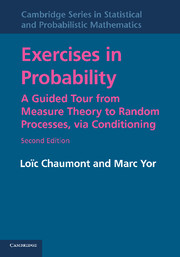
-
Exercises in Probability
- A Guided Tour from Measure Theory to Random Processes, via Conditioning
- 2nd edition
- Loïc Chaumont , Marc Yor
- Published online: 05 August 2012
- Print publication: 19 July 2012
-
- Book
-
- Get access
-
- Export citation
-
-
Derived from extensive teaching experience in Paris, this second edition now includes over 100 exercises in probability. New exercises have been added to reflect important areas of current research in probability theory, including infinite divisibility of stochastic processes, past-future martingales and fluctuation theory. For each exercise the authors provide detailed solutions as well as references for preliminary and further reading. There are also many insightful notes to motivate the student and set the exercises in context. Students will find these exercises extremely useful for easing the transition between simple and complex probabilistic frameworks. Indeed, many of the exercises here will lead the student on to frontier research topics in probability. Along the way, attention is drawn to a number of traps into which students of probability often fall. This book is ideal for independent study or as the companion to a course in advanced probability theory.
-

Cambridge Series In Statistical And Probabilistic Mathematics Pdf
Source: https://www.cambridge.org/core/series/cambridge-series-in-statistical-and-probabilistic-mathematics/8278B98D68B759B9185B2C6E6611A054
Posted by: perezbaces1957.blogspot.com

0 Response to "Cambridge Series In Statistical And Probabilistic Mathematics Pdf"
Post a Comment